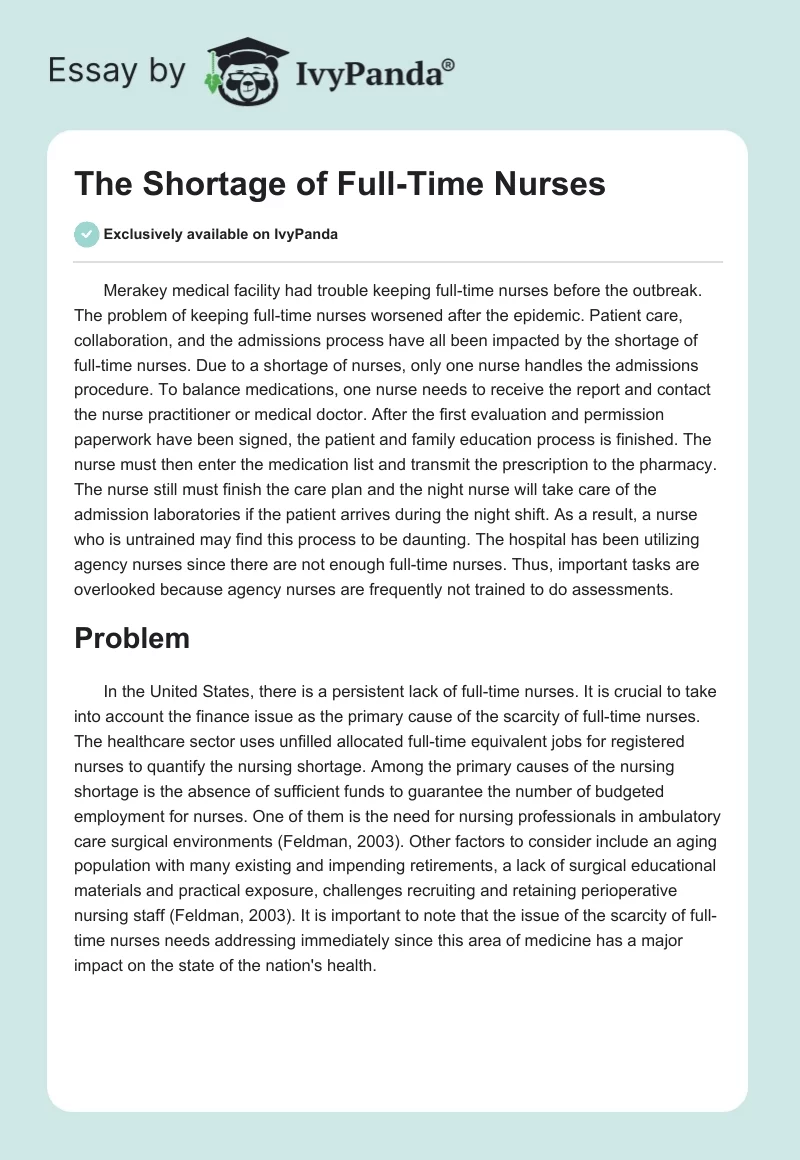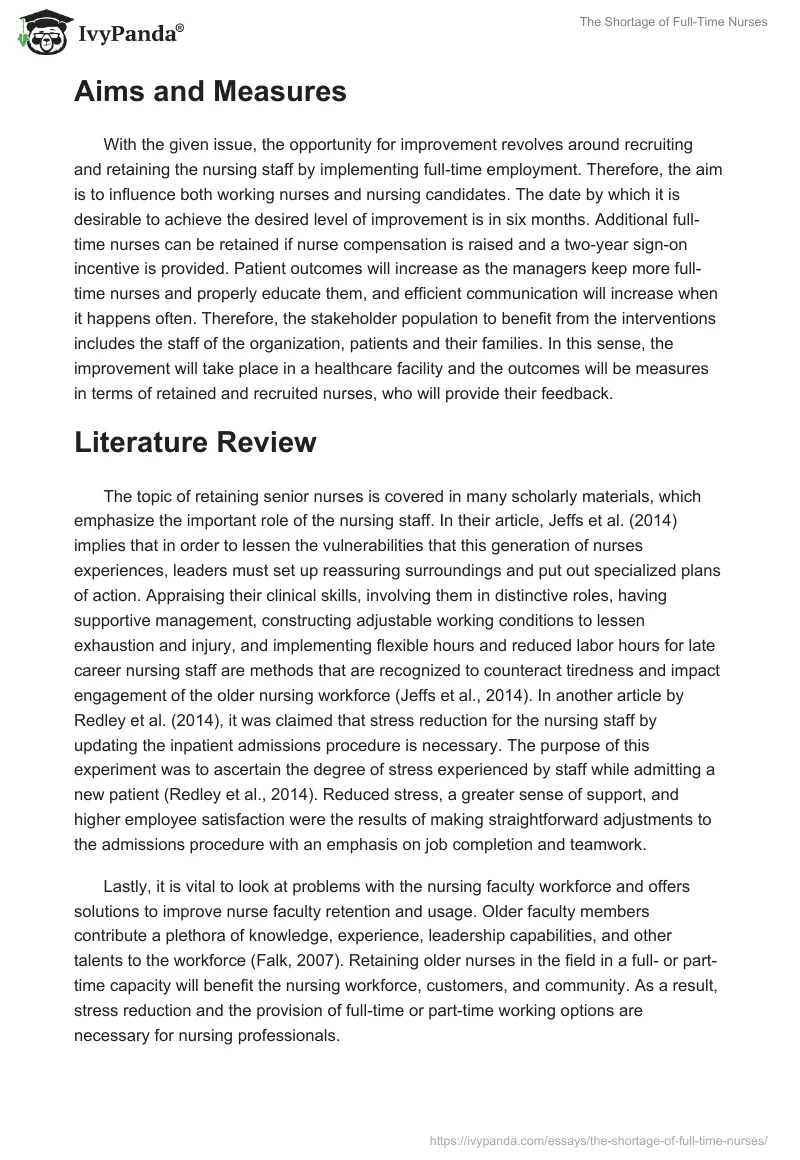Merakey medical facility had trouble keeping full-time nurses before the outbreak. The problem of keeping full-time nurses worsened after the epidemic. Patient care, collaboration, and the admissions process have all been impacted by the shortage of full-time nurses. Due to a shortage of nurses, only one nurse handles the admissions procedure. To balance medications, one nurse needs to receive the report and contact the nurse practitioner or medical doctor. After the first evaluation and permission paperwork have been signed, the patient and family education process is finished. The nurse must then enter the medication list and transmit the prescription to the pharmacy. The nurse still must finish the care plan and the night nurse will take care of the admission laboratories if the patient arrives during the night shift. As a result, a nurse who is untrained may find this process to be daunting. The hospital has been utilizing agency nurses since there are not enough full-time nurses. Thus, important tasks are overlooked because agency nurses are frequently not trained to do assessments.
Problem
In the United States, there is a persistent lack of full-time nurses. It is crucial to take into account the finance issue as the primary cause of the scarcity of full-time nurses. The healthcare sector uses unfilled allocated full-time equivalent jobs for registered nurses to quantify the nursing shortage. Among the primary causes of the nursing shortage is the absence of sufficient funds to guarantee the number of budgeted employment for nurses. One of them is the need for nursing professionals in ambulatory care surgical environments (Feldman, 2003). Other factors to consider include an aging population with many existing and impending retirements, a lack of surgical educational materials and practical exposure, challenges recruiting and retaining perioperative nursing staff (Feldman, 2003). It is important to note that the issue of the scarcity of full-time nurses needs addressing immediately since this area of medicine has a major impact on the state of the nation’s health.
Aims and Measures
With the given issue, the opportunity for improvement revolves around recruiting and retaining the nursing staff by implementing full-time employment. Therefore, the aim is to influence both working nurses and nursing candidates. The date by which it is desirable to achieve the desired level of improvement is in six months. Additional full-time nurses can be retained if nurse compensation is raised and a two-year sign-on incentive is provided. Patient outcomes will increase as the managers keep more full-time nurses and properly educate them, and efficient communication will increase when it happens often. Therefore, the stakeholder population to benefit from the interventions includes the staff of the organization, patients and their families. In this sense, the improvement will take place in a healthcare facility and the outcomes will be measures in terms of retained and recruited nurses, who will provide their feedback.
Literature Review
The topic of retaining senior nurses is covered in many scholarly materials, which emphasize the important role of the nursing staff. In their article, Jeffs et al. (2014) implies that in order to lessen the vulnerabilities that this generation of nurses experiences, leaders must set up reassuring surroundings and put out specialized plans of action. Appraising their clinical skills, involving them in distinctive roles, having supportive management, constructing adjustable working conditions to lessen exhaustion and injury, and implementing flexible hours and reduced labor hours for late career nursing staff are methods that are recognized to counteract tiredness and impact engagement of the older nursing workforce (Jeffs et al., 2014). In another article by Redley et al. (2014), it was claimed that stress reduction for the nursing staff by updating the inpatient admissions procedure is necessary. The purpose of this experiment was to ascertain the degree of stress experienced by staff while admitting a new patient (Redley et al., 2014). Reduced stress, a greater sense of support, and higher employee satisfaction were the results of making straightforward adjustments to the admissions procedure with an emphasis on job completion and teamwork.
Lastly, it is vital to look at problems with the nursing faculty workforce and offers solutions to improve nurse faculty retention and usage. Older faculty members contribute a plethora of knowledge, experience, leadership capabilities, and other talents to the workforce (Falk, 2007). Retaining older nurses in the field in a full- or part-time capacity will benefit the nursing workforce, customers, and community. As a result, stress reduction and the provision of full-time or part-time working options are necessary for nursing professionals.
Plan for Change
After reviewing the literature given on the issue of nurse workload and care results, the planned change was established. The planned change involves recruiting or retaining more nursing personnel in order to provide quality care and divide the responsibility for the patient admission process. The given planned change implies that the admission process tasks are divided among several nurses. In this sense, one nurse can reconcile the medications with the doctor and put the care plan and orders in the system, the other nurse can complete the initial assessment and educate the family and patient. In this situation, the most critical problem is retaining full-time nurses for such processes. Therefore, the interventions for this plan will entail not only recruiting more nurses but overseeing the workload, the level of stress, and the provision of nursing training in order to provide support at all stages of work.
The potential parties responsible for the change are the leadership of the medical facilities and the HR department. In the first case, the management will need to understand the necessity of recruiting more nursing employees while allocating more funds for this purpose. Moreover, the managers of the nursing department will need to provide support and acknowledgment to the working employees. In the second case, the HR department will need to provide the necessary requirements to the new employees, striving to recruit competent candidates. As a result, the population affected by the intervention will include nursing staff and patients, with the first being accommodated with more comfortable work conditions and the second receiving quality care.
As for the financial implications, there might be both advantages and disadvantages for the plan. Among the disadvantages is the increased volume of funds that will be required to recruit and retain nursing professionals since increased compensation and expenses on more personnel will be involved. However, among the advantages is fewer litigation processes since, with increased quality of care, there will be fewer medical mistakes. Among the potential barriers to such a plan is the refusal of the management to hire more employees. In this sense, the point behind this is the fact that more funds or their reallocation will be required. However, it is vital to understand that such changes are needed within a short period of time. The proposed timeline for the given project will be six months, which will allow the HR department to recruit more employees, increase the compensation of the nurses in existing departments, and monitor the changes along with feedback. Thus, the given plan represents a segmented intervention aimed at recruiting and retaining.
References
Falk, N. L. (2007). Strategies to enhance retention and effective utilization of aging nurse faculty. The Journal of Nursing Education, 46(4), 165-169.
Feldman, H. (2003). The nursing shortage: Strategies for recruitment and retention in clinical practice and education. Springer Publishing Company.
Jeffs, L., Nincic, V., Hayes, L., Jerome, D., & Malecki, V. (2014). Insights from nurse leaders to optimize retaining late career nurses. Nursing Leadership (Toronto, Ont.), 27(3), 29–39.
Redley, B., Douglas, T., Hoon, L., de Courten, B., & Hutchinson, A. M. (2022). Nurses’ harm prevention practices during admission of an older person to the hospital: A multi‐method qualitative study. Journal of Advanced Nursing, 78(11), 3745-3759.


